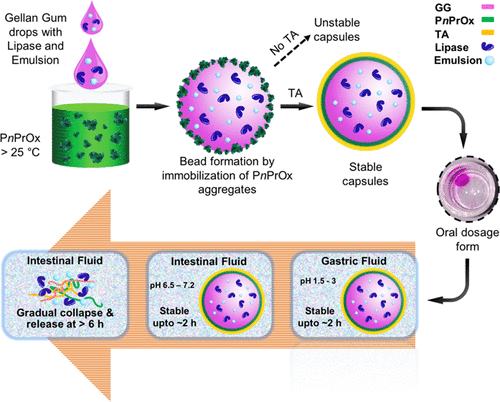当前位置:
X-MOL 学术
›
ACS Appl. Bio Mater.
›
论文详情
Our official English website, www.x-mol.net, welcomes your feedback! (Note: you will need to create a separate account there.)
Tannic Acid-Stabilized Self-Degrading Temperature-Sensitive Poly(2-n-propyl-2-oxazoline)/Gellan Gum Capsules for Lipase Delivery
ACS Applied Bio Materials ( IF 4.7 ) Pub Date : 2021-08-24 , DOI: 10.1021/acsabm.1c00697 Varsha Sharma 1 , Gokul Paramasivam 2 , Maarten Vergaelen 3 , Richard Hoogenboom 3 , Anandhakumar Sundaramurthy 1, 2
ACS Applied Bio Materials ( IF 4.7 ) Pub Date : 2021-08-24 , DOI: 10.1021/acsabm.1c00697 Varsha Sharma 1 , Gokul Paramasivam 2 , Maarten Vergaelen 3 , Richard Hoogenboom 3 , Anandhakumar Sundaramurthy 1, 2
Affiliation

|
In recent years, stable hydrogen-bonded stimuli-responsive polymer capsules have been receiving great interest for the encapsulation and release of sensitive molecules such as lipase enzymes. Compartmental capsules having a liquid gel core stabilized with temperature-responsive hydrogen-bonded multilayers are advantageous over other conventional systems because of their ability to maintain hydrophilic lipase and other hydrophobic compounds in compatible protected molecular vehicle environments and prolong their native properties, e.g., in the body. In this work, we report a methodology to stabilize an aqueous liquid gellan gum (GG) core in a capsule using neutral and nontoxic building blocks, namely, poly(2-n-propyl-2-oxazoline) (PnPrOx) and tannic acid (TA), to fabricate temperature-responsive capsules, comprising both lipase and hydrophobic oil droplets. The capsules were fabricated by adding GG droplets to a PnPrOx suspension at a temperature (T) higher than its cloud point temperature (TCP). Notably, the formed capsules were not stable in water without TA stabilization via hydrogen bonding. Scanning electron microscopy (SEM) investigations of the GG/building block interphase revealed that the collapsed PnPrOx globules that are present above the TCP stabilized the GG interphase as a Pickering emulsion, while undergoing a configurational transformation into its linear form by interacting with TA in the next step of capsule formation resulting in a smooth PnPrOx/TA capsule wall. The encapsulation efficiencies of the capsules for model fluorescent molecules were found to be 52, 54, and 24% for FITC-dextran, rhodamine, and Nile red, respectively. The stability experiments exhibited swelling and shell thinning at certain locations followed by complete rupture of the capsules at 37 °C, while the capsules were stable for several weeks at temperatures below the TCP of PnPrOx. The capsules were found to be stable in stimulated gastric fluid (SGF) for several hours at 37 °C while successfully releasing the encapsulated lipase and Nile red (model hydrophobic compound) in stimulated intestinal fluid (SIF). The released lipase was found to retain almost 100% of its activity. The reported capsules have high potential for use as carriers for encapsulation and release of a variety of payloads ranging from proteins and vitamin supplements to enzymes and probiotics through the oral route of administration.
中文翻译:

单宁酸稳定的自降解温度敏感性聚(2-n-丙基-2-恶唑啉)/结冷胶胶囊用于脂肪酶递送
近年来,稳定的氢键刺激响应聚合物胶囊在脂肪酶等敏感分子的封装和释放方面引起了极大的兴趣。具有用温度响应性氢键多层稳定的液体凝胶核心的隔间胶囊优于其他常规系统,因为它们能够在相容的受保护分子载体环境中保持亲水性脂肪酶和其他疏水性化合物并延长它们的天然特性,例如在身体。在这项工作中,我们报告了一种使用中性和无毒的结构单元,即聚( 2- n-丙基-2-恶唑啉)(P nPrOx) 和单宁酸 (TA),用于制造温度响应胶囊,包括脂肪酶和疏水油滴。通过在高于浊点温度 ( T CP ) 的温度 ( T ) 下将 GG 液滴添加到 P n PrOx 悬浮液中来制造胶囊。值得注意的是,形成的胶囊在没有通过氢键的 TA 稳定的情况下在水中不稳定。对 GG/积木界面的扫描电子显微镜 (SEM) 研究表明,存在于T CP上方的塌陷的 P n PrOx 小球稳定GG界面相作为Pickering乳液,同时通过在胶囊形成的下一步中与TA相互作用而将构型转变为其线性形式,从而产生光滑的P n PrOx / TA胶囊壁。发现模型荧光分子的胶囊对 FITC-葡聚糖、罗丹明和尼罗红的封装效率分别为 52%、54% 和 24%。稳定性实验显示在某些位置膨胀和壳变薄,随后胶囊在 37°C 完全破裂,而胶囊在低于P n的T CP的温度下稳定数周普罗克斯。发现胶囊在受刺激的胃液 (SGF) 中可在 37 °C 下稳定数小时,同时在受刺激的肠液 (SIF) 中成功释放封装的脂肪酶和尼罗红(模型疏水化合物)。发现释放的脂肪酶保留了几乎 100% 的活性。报道的胶囊具有很高的潜力,可用作封装和释放各种有效载荷的载体,从蛋白质和维生素补充剂到酶和益生菌,通过口服给药途径。
更新日期:2021-09-20
中文翻译:

单宁酸稳定的自降解温度敏感性聚(2-n-丙基-2-恶唑啉)/结冷胶胶囊用于脂肪酶递送
近年来,稳定的氢键刺激响应聚合物胶囊在脂肪酶等敏感分子的封装和释放方面引起了极大的兴趣。具有用温度响应性氢键多层稳定的液体凝胶核心的隔间胶囊优于其他常规系统,因为它们能够在相容的受保护分子载体环境中保持亲水性脂肪酶和其他疏水性化合物并延长它们的天然特性,例如在身体。在这项工作中,我们报告了一种使用中性和无毒的结构单元,即聚( 2- n-丙基-2-恶唑啉)(P nPrOx) 和单宁酸 (TA),用于制造温度响应胶囊,包括脂肪酶和疏水油滴。通过在高于浊点温度 ( T CP ) 的温度 ( T ) 下将 GG 液滴添加到 P n PrOx 悬浮液中来制造胶囊。值得注意的是,形成的胶囊在没有通过氢键的 TA 稳定的情况下在水中不稳定。对 GG/积木界面的扫描电子显微镜 (SEM) 研究表明,存在于T CP上方的塌陷的 P n PrOx 小球稳定GG界面相作为Pickering乳液,同时通过在胶囊形成的下一步中与TA相互作用而将构型转变为其线性形式,从而产生光滑的P n PrOx / TA胶囊壁。发现模型荧光分子的胶囊对 FITC-葡聚糖、罗丹明和尼罗红的封装效率分别为 52%、54% 和 24%。稳定性实验显示在某些位置膨胀和壳变薄,随后胶囊在 37°C 完全破裂,而胶囊在低于P n的T CP的温度下稳定数周普罗克斯。发现胶囊在受刺激的胃液 (SGF) 中可在 37 °C 下稳定数小时,同时在受刺激的肠液 (SIF) 中成功释放封装的脂肪酶和尼罗红(模型疏水化合物)。发现释放的脂肪酶保留了几乎 100% 的活性。报道的胶囊具有很高的潜力,可用作封装和释放各种有效载荷的载体,从蛋白质和维生素补充剂到酶和益生菌,通过口服给药途径。



























 京公网安备 11010802027423号
京公网安备 11010802027423号